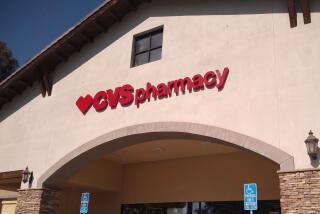Strategies : High Tech Approach to Drug Distribution : Pioneering Efforts With Computer Systems Are Paying Handsomely for Bergen Brunswig
When Emil P. Martini Jr.’s new IBM business computer balked at reading punch cards in 1963, he sent a call for help. To his amazement, it was answered by then-IBM Chairman Thomas Watson Jr.
Not only did Watson make sure the bugs in one of IBM’s pioneer business computers were quickly worked out, he struck up a lasting relationship with Martini and his wholesale pharmaceutical business in Bergen County, N.J.
Working together, Martini and Watson developed an automated accounting and inventory system, custom-designed for the needs of drug distributors.
Today, Bergen Brunswig Corp. spends more than $350,000 a month to lease IBM computer hardware. With the help of advanced computer technology, Bergen Brunswig has helped transform the way that pharmaceutical products, from antibiotics to pregnancy test kits, get from their manufacturers to the pharmacies that dispense them.
By providing extensive distribution networks and technological support, such as computer-assisted ordering, wholesalers such as Orange County-based Bergen Brunswig have become increasingly popular with both drug makers and drug sellers.
Bigger Firm Acquired in ’69
As a result, the proportion of drugs sold through distributors has increased by more than 50% in less than 15 years.
In 1969, the Bergen Drug Co., founded by Emil Martini Sr. in 1947, acquired the much larger Brunswig Drug Co., an enterprise started by French emigrant pharmacist Lucien Brunswig in Los Angeles in 1888. At the time of the merger, the combined companies posted $180 million in annual sales and claimed about 5% of the wholesale drug market.
Bergen Brunswig, which moved its headquarters to Orange in 1985, now reports annual sales of $3.4 billion. Most of that--$2.8 billion--is generated by the company’s wholesale drug business, which has captured about 16% of the national market. The company is also the nation’s largest distributor of videotaped movies.
Martini, the company’s chairman and chief executive officer, said Bergen Brunswig is striving for an even bigger slice of the national drug distribution market, which is expected to burgeon with the introduction of new products and the aging of the baby boom generation.
Robert Martini, Emil’s younger brother and the company’s president and chief operating officer, sees tremendous growth opportunities in the years ahead. “We have the opportunity to more than triple our business between now and the year 2000,” he said.
Bergen Brunswig officials said the company has no immediate plans to acquire smaller firms, but they do not rule out acquisitions. Industry analysts point out that the company will have $40 million available for expansion plans or a buyback of stock in January after completion of the recently announced sale of its hospital supply division.
Although Bergen Brunswig owes most of its success to the wholesale drug business where it started, it has ventured into other areas over the years--with varying results.
John T. Fay Jr., Bergen Brunswig’s director of corporate affairs, recalled that the company once started a vitamin-manufacturing operation but gave up when it failed to gain a sufficient foothold in the market.
In 1982, the company acquired Commtron, a Des Moines distributor of consumer electronics. The plan, Fay said, was to offer a line of digital watches, hand-held computers and other electronic items for sale in pharmacies.
By sheer “serendipity,” Fay said, the acquisition coincided with a national boom in the home video market. Commtron, which in 1982 had only a fledgling wholesale video business, quickly became the nation’s largest distributor of videotaped movies, sold principally through video specialty stores.
Because of the video craze, Commtron’s sales exploded to $442 million from $45 million in just four years.
Last year, however, Commtron’s growth tapered off abruptly. During the fiscal year ended Aug. 31, the subsidiary’s operating earnings declined 59% to $5.5 million from $13.4 million. But George E. Reinhardt Jr., Bergen Brunswig’s chief financial officer, said the future looks bright for Commtron because of an expected increase this year in the number of video movie releases and the anticipated introduction of new electronic consumer products.
Same Basic Strategies
Although its home video and pharmaceutical operations may seem poles apart, Bergen Brunswig’s corporate officers point out that both are engaged in the distribution business and can benefit from the same basic automation strategies.
Not all of Bergen Brunswig’s diversification moves have been lasting. The company recently agreed to sell its medical supply subsidiary, which supplies hospitals with such items as needles and catheters, to a group of private investors, including the subsidiary’s top management.
Bergen Brunswig officers said the return on investment in the hospital supply business has been severely eroded by price competition among wholesalers and cost containment policies enforced by government and private insurance carriers.
But they said orders of drugs from hospital pharmacies are not declining, partly because patients who are sent home early take medications with them.
Bergen Brunswig officials frequently refer to the company as the “Avis” of the wholesale drug industry, second only to McKesson Corp. in San Francisco and striving hard to close the gap. The company has 10,000 customers, including independent, chain-owned and hospital pharmacies, and about 700 suppliers, including major drug manufacturers from Abbott to Upjohn.
With a national work force of 4,000 employees, Bergen Brunswig has thrived in a consolidating industry in which hundreds of other family-founded operations have collapsed or sold out in the last 20 years.
Six Companies Purchased
As surviving companies competed for a greater market share, Bergen Brunswig expanded through strategic acquisitions, spending $200 million in 1985-86 to buy six drug distribution companies that generated about $1 billion in annual sales.
Bergen Brunswig has concentrated its sales force and distribution warehouses in Sunbelt states, which account for a disproportionately large share of the nation’s population growth, especially among the elderly.
In addition, by pitching the cost-saving aspect of its automated services, Martini said the company has become the nation’s largest supplier of drugs to hospital pharmacies.
Bergen Brunswig officers said their fundamental strategy was to be one of the first drug wholesalers to offer high-technology services to gain customer loyalty and an increased market share in an industry that depends on high volume sales to offset low profit margins.
In 1974, the company bought hand-held devices that allowed pharmacists to punch drug orders onto a cassette tape that communicated through telephone lines with a Bergen Brunswig computer.
The data-recording devices, which were later computerized, enabled Bergen Brunswig to eliminate a costly boiler room of order takers. They also improved the speed and accuracy with which orders were filled.
By offering various computer-related services, the company persuaded many pharmacies, which until then had been buying drugs from other wholesalers or directly from manufacturers, to place the bulk of their orders with Bergen Brunswig.
Calculations for Pharmacists
By computerizing data, Bergen Brunswig can calculate for each of its pharmacist customers the profits generated by the various drugs on the shelves. The company also custom-prints price tags for pharmaceutical products, reflecting each store’s customary markup.
Mark Felder, a securities analyst with Legg Mason, said Bergen Brunswig’s managers were “pioneers in the use of direct order entry. It helped them become one of the more efficient distributors and pick up market share.”
Fay said the automated ordering process “revolutionized” the wholesale drug industry, with other wholesalers adopting similar technologies to expand their business. Since the introduction of the equipment in 1974, he said the proportion of drugs sold through distributors instead of directly to pharmacies has increased from 45% to 70%, with Bergen Brunswig capturing a big portion of the increase.
In recent years, the company has made increasing use of computer automation to eliminate the paper work in its transactions with drug manufacturers. And it is introducing advanced computer automation at a warehouse under construction in Valencia.
At the new warehouse, order-reading computers will signal devices to push the appropriate drugs off shelves and into bins for shipment.
BERGEN BRUNSWIG AT A GLANCE
Based in Orange, Bergen Brunswig is a national distributor of pharmaceuticals, health care products, medical and surgical supplies, consumer electronics and prerecorded videocassettes. In the past five years, the company’s sales have more than tripled to $3.4 billion. Bergen Brunswig and its three subsidiaries have 4,000 employees and distribute products from 65 warehouses.
Year ends Aug. 31
(in millions) 1987 1986 1985 1984 1983 Revenue $3,376.0 $3,065.5 $2,434.9 $1,703.4 $1,418.8 Net income 15.9 20.6 23.3 23.4 21.1
Assets: $785.0 million Employees: 4,000 Shares outstanding: 13.3 million 52-week price range: $27.00-$14.675 Monday’s close (AMEX): $15.00
More to Read
Inside the business of entertainment
The Wide Shot brings you news, analysis and insights on everything from streaming wars to production — and what it all means for the future.
You may occasionally receive promotional content from the Los Angeles Times.










